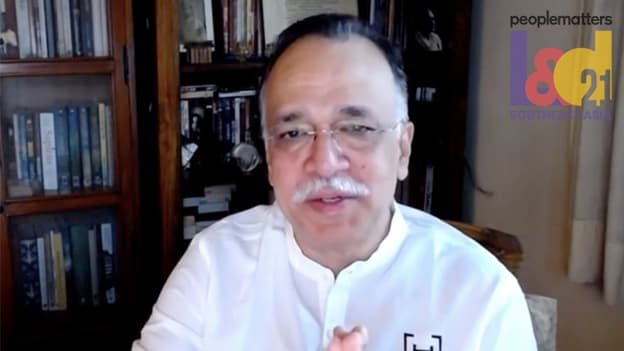Here are the three focus areas that agile leaders need

“The COVID19 crisis has been a time of accelerating disruption in our lives,” said Pramath Raj Sinha, Founder and Chairman, Harappa Education addressing a live audience at the People Matters L&D SEA Conference 2021.
The major disruptions affecting the world of business have been in-progress for the last few decades, he noted. Reflecting on his own career, Sinha pointed out that digitization has bridged the boundaries between industries. So much so that a transportation company is in the business of food, and an ecommerce company is delivering groceries.
“Now, with the rise of data and algorithms, the very nature of business forecasting has changed.” He said. And added to this is the shift in skills that’s required at the workplace.
All of these shifts are happening simultaneously—and it places tremendous burden on leaders today. In fact, even the best leaders have not seen this pace of change in the world of business. And it's directly affecting their cognitive and emotional capacities.
Noting that it is important to pay attention to the impact that this has on individual leaders, Sinha highlighted three forms of agility that leaders need today.
“We are dealing with a fog of uncertainty and a lack of clear answers,” he said. While it may have always been the case, and some leaders may be better primed based on their experience in specific industries, what’s unique today is the pace of change. And the worry is whether leaders may be out of sync and their ability of dealing with these issues may be limited.
There is a need for inner agility among leaders and here’s what they need to focus on:
- Cognitive agility: We’re constantly being bombarded with information and data;and all of it coming to you on a daily and hourly basis. We need to develop very different mental models, mindsets and attitudes. We need to constantly reframe the way we look at the world—from how we were able to do before.We need to stop, pause and think more often even as we’re trying to do things faster. For example: How are you thinking differently about product launches? What do you think about testing new ideas?
- Emotional agility: The emotions that leaders at all levels have to deal with include catering to teams, bosses, families, customers, vendors has gone up. Speaking of his own career growth, Sinha noted that the workplace today expects leaders to be more vulnerable, feedback-oriented, open and transparent. And when employees go through emotional challenges, they expect their leaders to support them through the process. And when employees aren’t always forthcoming, leaders need to learn how to read situations and understand stressors—both personal and professional.
- Learning agility: On business skills, technical skills and personal leadership skills, there’s always an opportunity to learn. Businesses today are training employees on better understanding data and analytics; they’re also investing in understanding the impact of AI, machine learning and algorithms. And it’s immensely valuable to the business. Many of these skills can be learned online.
There’s an interest today in the sixty year curriculum—premised on the idea that jobs and skills will continue to change. And that is the future we are looking towards. Leaders need to be flexible and willing to learn new behavioural and skills too.
















